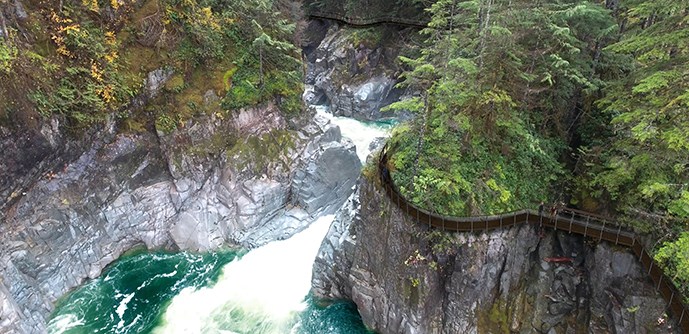Since the concept of the Squamish Canyon was announced last fall, crowd equity raised $282,000 for the multifaceted destination project.
Unlike crowdfunding, crowd equity lets people invest in shares of a company or project rather than donate to a cause.
Canyon founder Robin Sherry said he chose a crowd equity model "So the community could own part of the project and be shareholders and ambassadors — not just the one percentile owning large swaths of what happens in the community — but allowing our smaller individuals and community members to be part of the developments that are happening in Squamish."
Between October and mid-January, 31 local investors pitched in $250 to $5,000 each to reach the Canyon's minimum goal before the campaign was closed. (Sherry said they may reopen crowd equity options later.) The total price of the project is estimated to be $4 to 5 million.
The designs of the proposed walkway feature a zero-waste café, event and artisan space, a covered outdoor playground and educational components with information about geology, ecology, safety and First Nations. Overhead canopies would allow the venue to be open year-round, so visitors could still go outside during the rainy season.
Where salmon habitat exists at the edge of the tenure, Sherry is considering adding cameras so that visitors can watch the salmon from above and in the water, and continue to watch from home.
Sherry said they will share the site plan soon, but it won't include a map or address for the location. They're not disclosing that information until the infrastructure is in place, in order to help with preservation.
"What is happening right now is it's getting goat-trailed and braided," Sherry said. "Visitors don't really have the ability to stray off from what we're creating.
"We're trying to create something that actually lessens the footprint of visitors here, not increase it. The visitors are coming. This is what a lot of people don't understand: We are at the infancy. We either start being proactive on how we're going to deal with the popularity of this area or we're reactive. And that is not good. We either choose to figure out good ways for our community to have space and our visitors to have a safe enjoyable experience or we tax our system."
Sherry said there's been a lot of misunderstanding in the community about the for-profit project.
"A lot of people think that everything they used to be able to access will be cut off," he said, adding the kayak site, swimming holes and most of the trails there will not be impacted by the Canyon.
"We'll also be working with local recreational organizations like slackliners, climbers and kayakers to find the best liability level possible so they can still access and do what they do in there, but without causing any ill effect to the operation or project," he said.
After being asked by The Chief for comment, on Jan. 18, the Squamish Access Society wrote a press release about the Canyon, in which it says there is one climbing route but the Canyon's tenure predates the bolting. Sherry and the route setter have been in touch about access.
"Overall our judgment is that there is not sufficient reason for SAS to oppose the project, so our position is neutral," the press release said.
Another misconception, Sherry said, is that the land is a pristine, untouched natural area.
However, much of the 26-acre area has been logged, and there are two powerlines, three roads, a railway and a pipeline running through it.
"We worked closely with the lands department and our local loggers to be able to divert a portion of this land from being logged and used for canyon eco-tours," Sherry said. "One of the things we wanted to show was how tourism and community space and industry could all coexist together, and how heavily used land can be reclaimed and turned into something that could be preserved."
He's also heard community members are concerned about road use and parking. Sherry said the Squamish Canyon will be a main contributor to upgrading the road. Parking will be underneath pre-existing powerlines.
Once the Squamish Canyon is open, Sherry said they will have between eight and 15 employees to start. Depending on how the Canyon develops, that number could double. Recruitment and retention ideas include providing alternative transportation for employees, which could be in the form of e-bikes.
Sherry said he hopes the Squamish Canyon will be open to visitors in 2019 but did not give a specific timeframe. A scan of the canyon and a preliminary design has been completed, with two or three months of engineering for the walkway infrastructure before construction can begin.
~With files from Haley Ritchie.




